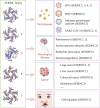The Emerging Role of the Serine Incorporator Protein Family in Regulating Viral Infection
- PMID: 35433679
- PMCID: PMC9010877
- DOI: 10.3389/fcell.2022.856468
The Emerging Role of the Serine Incorporator Protein Family in Regulating Viral Infection
Abstract
Serine incorporator (SERINC) proteins 1-5 (SERINC1-5) are involved in the progression of several diseases. SERINC2-4 are carrier proteins that incorporate the polar amino acid serine into membranes to facilitate the synthesis of phosphatidylserine and sphingolipids. SERINC genes are also differentially expressed in tumors. Abnormal expression of SERINC proteins occurs in human cancers of the breast, lung, colon, liver, and various glands, as well as in mouse testes. SERINC proteins also affect cleft lip and palate and nerve-related diseases, such as seizure Parkinsonism and borderline personality. Moreover, SERINC proteins have garnered significant interest as retroviral restriction factors, spurring efforts to define their function and elucidate the mechanisms through which they operate when associated with viruses. Human SERINC proteins possess antiviral potential against human immunodeficiency virus (HIV), SARS-COV-2, murine leukemia virus (MLV), equine infectious anemia virus (EIAV), and hepatitis B virus (HBV). Furthermore, the crystal structure is known, and the critical residues of SERINC5 that act against HIV have been identified. In this review, we discuss the most prevalent mechanisms by which SERINC3 and SERINC5 antagonize viruses and focus on the potential therapeutic applications of SERINC5/3 against HIV.
Keywords: COVID-19; DNA virus; HIV; SERINC; influenza virus; retroviral virus.
Copyright © 2022 Xu, Zheng, Pathak, Cheng, Zhou, Chen, Wu, Wang, Zeng and Wu.
Conflict of interest statement
The authors declare that the research was conducted in the absence of any commercial or financial relationships that could be construed as a potential conflict of interest.
Figures




Similar articles
-
Beyond Impairment of Virion Infectivity: New Activities of the Anti-HIV Host Cell Factor SERINC5.Viruses. 2024 Feb 12;16(2):284. doi: 10.3390/v16020284. Viruses. 2024. PMID: 38400059 Free PMC article. Review.
-
SERINC5 counters retroviruses and non-retroviruses.Front Cell Infect Microbiol. 2025 Jan 20;14:1516806. doi: 10.3389/fcimb.2024.1516806. eCollection 2024. Front Cell Infect Microbiol. 2025. PMID: 39902183 Free PMC article. Review.
-
SERINC5 Potently Restricts Retrovirus Infection In Vivo.mBio. 2020 Jul 14;11(4):e00588-20. doi: 10.1128/mBio.00588-20. mBio. 2020. PMID: 32665269 Free PMC article.
-
S2 from equine infectious anemia virus is an infectivity factor which counteracts the retroviral inhibitors SERINC5 and SERINC3.Proc Natl Acad Sci U S A. 2016 Nov 15;113(46):13197-13202. doi: 10.1073/pnas.1612044113. Epub 2016 Nov 1. Proc Natl Acad Sci U S A. 2016. PMID: 27803322 Free PMC article.
-
The antiviral activity of rodent and lagomorph SERINC3 and SERINC5 is counteracted by known viral antagonists.J Gen Virol. 2019 Feb;100(2):278-288. doi: 10.1099/jgv.0.001201. Epub 2018 Dec 19. J Gen Virol. 2019. PMID: 30566072
Cited by
-
In Cerebellar Atrophy of 12-Month-Old ATM-Null Mice, Transcriptome Upregulations Concern Most Neurotransmission and Neuropeptide Pathways, While Downregulations Affect Prominently Itpr1, Usp2 and Non-Coding RNA.Cells. 2023 Oct 3;12(19):2399. doi: 10.3390/cells12192399. Cells. 2023. PMID: 37830614 Free PMC article.
-
Beyond Impairment of Virion Infectivity: New Activities of the Anti-HIV Host Cell Factor SERINC5.Viruses. 2024 Feb 12;16(2):284. doi: 10.3390/v16020284. Viruses. 2024. PMID: 38400059 Free PMC article. Review.
-
Integrative Methylome and Transcriptome Characterization Identifies SERINC2 as a Tumor-Driven Gene for Papillary Thyroid Carcinoma.Cancers (Basel). 2022 Dec 30;15(1):243. doi: 10.3390/cancers15010243. Cancers (Basel). 2022. PMID: 36612238 Free PMC article.
-
Viral Membrane Fusion: A Dance Between Proteins and Lipids.Annu Rev Virol. 2023 Sep 29;10(1):139-161. doi: 10.1146/annurev-virology-111821-093413. Annu Rev Virol. 2023. PMID: 37774128 Free PMC article. Review.
-
SERINC5 counters retroviruses and non-retroviruses.Front Cell Infect Microbiol. 2025 Jan 20;14:1516806. doi: 10.3389/fcimb.2024.1516806. eCollection 2024. Front Cell Infect Microbiol. 2025. PMID: 39902183 Free PMC article. Review.
References
-
- Alli-Balogun G. O., Levine T. P. (2021). Fungal Ice2p Is in the Same Superfamily as SERINCs, Restriction Factors for HIV and Other Viruses. Proteins-Structure Funct. Bioinformatics 89 (10), 1240–1250. - PubMed
-
- Beekman M., Schutte B. A. M., Akker E. B. V. D., Noordam R., Dibbets-Schneider P., De Geus-Oei L. F., et al. (2020). Lifestyle-Intervention-Induced Reduction of Abdominal Fat Is Reflected by a Decreased Circulating Glycerol Level and an Increased HDL Diameter. Mol. Nutr. Food Res. 64 (10), e1900818. 10.1002/mnfr.201900818 - DOI - PMC - PubMed
-
- Bhoj V. G., Thibodeaux S. R., Levine B. L. (2016). Novel Gene and Cellular Therapy Approaches for Treating HIV. Discov. Med. 21 (116), 283–292. - PubMed
Publication types
LinkOut - more resources
Full Text Sources
Miscellaneous

